

First Lady Michelle Obama addresses White House tribal youth gathering.
On July 9, 2015, the White House hosted more than 1,000 youth for its first-ever tribal youth gathering. Cosponsored by UNITY, the event builds on President Obama's Generation Indigenous (Gen-I) initiative, which aims to improve the lives of Native youth through new investments and increased engagement. Youth ages 14 to 24 were eligible to attend the event by joining the National Native Youth Network and accepting the Gen-I challenge.
Native youth were involved in planning the event through participation in the White House Tribal Youth Gathering Steering Committee. The OJJDP-sponsored Today’s Native Leaders (TNL) program also played a key role in the event. TNL facilitators educated the audience about the initiative and the ongoing opportunities for leadership training for Native youth that occur throughout the country. Examples of innovative service projects completed by TNL alumni were also featured during the event.
First Lady Michelle Obama, who was introduced by 15-year-old Hamilton Seymour of the Nooksack Indian Tribe, delivered the keynote address. In her remarks, Mrs. Obama acknowledged the history of oppression that impacts tribes and encouraged the attendees to embrace their heritage, telling the youth that their customs, values, and discoveries are “at the heart of the American story.”
The First Lady also spoke about the value of education, urged the youth to build peer networks to effect change, and encouraged them to persevere through challenging times. “Like many young people your age, I know that you may have moments in your lives when you’re filled with doubts, or you feel weighed down by history or stifled by your circumstances, or think that no one really understands what you’re going through,” said Mrs. Obama. “But, when you start to feel that way, I want you all to remember one simple but powerful truth—that every single one of your lives is precious and sacred, and each of you was put on this earth for a reason.”
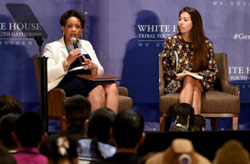
Attorney General Loretta Lynch (left) answers questions posed by the youth during a fireside chat on public safety and strong communities.
The participating youth, representing 230 tribes from 42 states, were afforded the opportunity to interact directly with senior Administration officials and officials from the White House Council on Native American Affairs. In a fireside chat on public safety and strong communities, Attorney General Lynch outlined the Justice Department’s efforts on behalf of native youth and their communities, which include establishing a task force to study and recommend solutions to American Indian and Alaska Native children’s exposure to violence. When asked how the attendees could capitalize on their experiences at the gathering, the Attorney General responded: “Try to find one or two ideas you can take back to your communities. [T]his is a time of great change in this country and, so often, that change has been led by young people. You have the energy, the dedication, and the vision. [B]e the one to tell your story.”
Other fireside chats included a session on health and wellness with Department of Health & Human Services Secretary Sylvia Burwell; Director of the White House Domestic Policy Council Cecilia Muñoz; and Senator Heidi Heitkamp as well as a session on youth opportunity with Secretary of the Interior Sally Jewell; Secretary Julián Castro of the Department of Housing and Urban Development; and Gina McCarthy, Administrator of the Environmental Protection Agency. In the latter session, youth asked questions about the usefulness of the Affordable Care Act for their communities, the lack of federal funds set aside for Indian Country, and national efforts to support wellness and mental health services for Native youth, among others. They also expressed overwhelming support for the Violence Against Women Reauthorization Act of 2013, which grants tribal courts jurisdiction over non-Native people who commit domestic violence acts on tribal lands.Other speakers at the event included Brian Cladoosby, president of the National Congress of American Indians and chairman of the Swinomish Nation; John Herrington, Ph.D., former NASA astronaut and member of the Chickasaw Nation; Sam McCracken, Nike N7 creator; and Cheyenne Brady, Miss Indian World. Assistant Attorney General Karol V. Mason participated in the “Emerging Youth Leaders” panel while OJJDP Administrator Robert L. Listenbee moderated the “Tribal Justice, Caring for Our Youth” session.
Resources:
Learn more about White House programs and initiatives to support native youth.
To learn more about OJJDP’s tribal youth programs and services, visit the Office’s website.
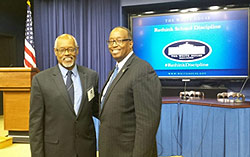
OJJDP Administrator Robert L. Listenbee (right) and Harold Jordan, Senior Policy Advocate of the American Civil Liberties Union of Pennsylvania (and coordinating council member of the Dignity in Schools Campaign) at the July 22, 2015, Rethink School Discipline Conference.
On July 22, 2015, the White House hosted Rethink School Discipline, a national convening on improving school discipline practices and creating positive school climates. The event brought together leaders from the Departments of Justice (DOJ), Education (ED), and Health and Human Services’ Substance Abuse and Mental Health Services Administration as well as schools and nonprofit organizations around the country.
The stakeholders gathered to advance the conversation about replacing overused out-of-school suspensions, expulsions, and referrals to law enforcement with positive, effective alternatives that keep students in school and engaged in learning while holding them accountable for their actions.
The conference highlighted tools and resources from the Supportive School Discipline Initiative (a project sponsored jointly by DOJ and ED in collaboration with the U.S. Department of Health and Human Services) and offered best practices that communities can use to help children succeed and avoid contact with the juvenile and criminal justice systems.
OJJDP Administrator Robert L. Listenbee introduced U.S. Attorney General Loretta Lynch, thanking her for her work in support of the nation’s youth. “We are fortunate to have an Attorney General who is a champion for America’s young people, who supports effective collaboration to ensure that fair and equal treatment is the standard for all systems that serve our nation’s youth,” Mr. Listenbee said.
In her remarks, Attorney General Lynch discussed DOJ’s priorities, which include “making sure that all of our nation’s young people have an opportunity … to grow and to thrive no matter who they are, what they look like, or where they are from.” The Attorney General cited several federal initiatives, such as the OJJDP-supported Defending Childhood Initiative and National Forum on Youth Violence Prevention, that promote opportunities for young people and help them to break out of the cycle of violence. She described harsh and exclusionary discipline practices in America’s schools as “a trip wire that sends young people stumbling—often headfirst—into a vicious cycle of criminality and incarceration.”
Panels and presentations throughout the day explored how ineffective school discipline can lead youth to future contact with the juvenile and criminal justice systems. Presenters discussed the psychology and science behind addressing discrimination in schools, the disparate treatment of children of color, and the need to provide children with gateways to opportunity rather than to the juvenile and criminal justice systems. Midday breakout discussions addressed such topics as identifying the causes of discipline disparities, developing effective codes of conduct, and offering alternatives to exclusionary school discipline.
In a panel titled “Framing the School Discipline Challenge,” Catherine Lhamon and Vanita Gupta, Assistant Secretary and Acting Assistant Attorney General for Civil Rights, respectively, discussed the racial disparity in school suspensions and expulsions, the crackdown on youth offenders in the name of public safety, and how the increase in harsh disciplinary policies and law enforcement officers in schools has led to a rise in the number of students arrested or becoming involved in the juvenile and criminal justice systems.

Mr. Listenbee and Chief Judge Steven C. Teske of the Clayton County (GA) Juvenile Court at the July 22, 2015, convening.
One of the breakout sessions was a discussion on “Rules for Law Enforcement and the Courts” featuring Ronald L. Davis, Director of DOJ’s Office of Community Oriented Policing Services; Jennifer Eberhardt of Stanford University; Lisa H. Thurau, founder of Strategies for Youth; and Judge Steven C. Teske of the Clayton County (GA) Juvenile Court. The participants stressed the critical need to build relationships among law enforcement and young people in the community, to look for and address situations in which discrimination is likely, to ensure clarity regarding the role of law enforcement in schools, and to respond to disruptive behavior with creative solutions.
John Rosiak, consultant to the National Council of Juvenile and Family Court Judges provided a report out on the session to the wider audience and highlighted OJJDP’s new School Justice Collaboration program, which aims to enhance collaboration and coordination among schools, mental and behavioral health specialists, law enforcement, and juvenile justice officials to help students succeed in school and prevent negative outcomes for youth and communities.
“Creating and sustaining safe, supportive schools is absolutely essential to ensuring students can engage in the rich learning experiences they need for success in college, work, and life,” said U.S. Secretary of Education Arne Duncan in his remarks to conference attendees. Office of Special Education and Rehabilitative Services Assistant Secretary Michael Yudin and several senior Obama Administration officials also attended the conference.
Resources:
Visit the National Clearinghouse on Supportive School Discipline for resources and information to advance school discipline reform efforts.
Download the reports, Addressing the Root Causes of Disciplinary Disparities: An Educator's Action Planning Guide and Rethink School Discipline: School District Leader Summit on Improving School Climate and Discipline - Resource Guide for Superintendent Action, on the Education Department’s website.
Use the hashtag #RethinkDiscipline to continue the conversation on social media.
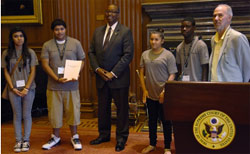
OJJDP Administrator Robert L. Listenbee with (left to right) student ambassadors Nancy Guandique, Johnnie Baites III, Catalina Quintana, and Justin Bronson. National Campaign to Stop Violence chairman Daniel Q. Callister stands behind the podium.
“To reduce the incidents of violence, we must first identify its causes, who’s affected, and what the risk factors are. What has been successful or unsuccessful in the past, and in what other areas? Answering these types of questions will provide the foundation for change, for growth, for a life free of violence.”
These are the words of 13-year-old Johnnie Baites III, a seventh grader from Corpus Christi, TX.
Johnnie shared these recommendations when he recounted his experience with violence at the U.S. Supreme Court in Washington, DC. Johnnie is 1 of 50 middle school students whom OJJDP Administrator Robert L. Listenbee helped welcome—along with their parents and guardians, and several juvenile court justices—to the “Do the Write Thing Challenge” culmination event held at the Supreme Court on July 13, 2015.
The hallmark program of the National Campaign to Stop Violence (NCSV), Do the Write Thing encourages middle school students to engage in discussions about youth violence with their teachers and peers, write about the causes and solutions, and pledge not to participate in violent acts. This year, more than 195,000 students nationwide participated in the classroom discussions, and 65,000 of those students accepted the “challenge” to prepare an essay and pledge nonviolence.
The 2015 winning essayists—referred to as national student ambassadors—represent 23 challenge programs in 17 states. The student ambassadors were invited to Washington, DC, to share their stories and learn about the nation’s capital. During the ceremony, four students, including Johnnie, read their essays in which they described their exposure to violence.
“Because I am Black or African American, and I live in a bad neighborhood, people look at me as a person who will be nothing in life,” wrote Justin Bronson, an eighth grader from Atlanta, GA, whose essay discussed gang activity in his neighborhood. “Though I cannot change my neighborhood, I can try to persuade those around me to do better. [M]y job as a young black man is to be a role model for my peers. I want to continue to ‘do the right thing.’”
In his remarks, Administrator Listenbee shared his experience with violence with the youth and outlined federal efforts—such as the Supportive School Discipline Initiative, the National Mentoring Resource Center, and the funding of family and juvenile drug courts—established to change circumstances for at-risk youth. Mr. Listenbee also emphasized OJJDP’s prioritization of youth and family engagement. “We know that youth and their families need to have a voice if we are to improve outcomes for our young people and their communities,” he said.
Nancy Guandique, an eighth grader from Memphis, TN, spoke about the despair she felt when her friend was killed by a stray bullet as he slept in his bed at night. Catalina Quintana, from El Paso, TX, detailed her experience as a witness to domestic violence. “It breaks my heart to look back at this time in my life. It affects you so much, especially emotionally,” said the eighth grader. “It’s like it’s eating you up alive and you think it’s never going to end.”
Johnnie concluded his essay by challenging himself and everyone around him to take the following pledge:
- Be careful of the words you speak—some words are more painful than a punch and as piercing as a knife.
- Treat friends and family the way you want them to treat you.
- Love without reason, and love everyone.
- Help someone else without expecting thanks or reward.
- Think before you act, before you speak, and before you assume.
- Learn to walk away. Be the bigger person.
- Learn to talk and problem solve without violence.
- Don’t be tempted to use drugs.
- Never be afraid to ask for help for you or someone else.
- Smile, you never know who needs to see it.
Resources
To read more about the National Campaign to Stop Violence and the Do the Write Thing Challenge, visit the NCSV website.
Learn more about the Attorney General’s Defending Childhood Initiative and access publications in OJJDP’s National Survey of Children’s Exposure to Violence series.
Access the Office for Victims of Crime’s (OVC’s) online series, "Through Our Eyes: Children, Violence, and Trauma." The series addresses the needs of children exposed to violence and victimization and covers topics, such as intervention in schools, violence in the home, evidence-based treatment, and child advocacy strategies. Access additional OVC resources for responding to child and youth victimization.
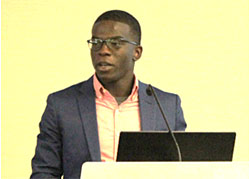
Keynote speaker, Theo Shaw, community advocate with the Southern Poverty Law Center. Photo courtesy of Megan Nibley, Coalition of Juvenile Justice.
Theo Shaw, keynote speaker at the Coalition for Juvenile Justice (CJJ) Youth Summit, which was cosponsored by OJJDP, was barely 2 minutes into his address when he stopped suddenly, breaking down in quiet sobs. He had been reading a poem written by one of the youth he visited in prison.
“This isn’t just work from the head; this is work from the heart,” said Marie Williams, CJJ executive director, taking to the podium briefly to stand alongside Shaw while he gathered himself.
Williams did not have to say much by way of explanation to the youth attendees in the room. Some of them had been system involved themselves; one had been released from jail the day before the summit. They all understood the intense passion that often goes into the work of advocating for youth in the system, and they had come from all over the country with a common mission—to learn how they could become better advocates and leaders.
Shaw is an exemplar of that mission. As a defendant in the “Jena 6” case, he spent 8 months in an adult jail pretrial. “I filed motion after motion after motion,” he said, all of which were denied, but the experience “gave me hope because it meant that I was communicating in their language.”
During his detention, Shaw gained firsthand experience of the plight of youth within the system. In his address, Shaw spoke passionately about the perils of solitary confinement, telling attendees that a lot of youth held in solitary confinement have intellectual and other disabilities that are exacerbated by the harsh treatment they receive. He spoke about the sexual and physical abuse that some of the children in the adult jails he visited in Louisiana and Mississippi as a youth advocate faced. He also spoke of young people being detained without access to medical, mental health, or educational services; injustices he felt would be alleviated if they had access to competent legal representation while in confinement. Despite all of the challenges, Shaw remains hopeful. “In being an advocate for our young people, I’ve learned very early the importance of holding on to our hope,” he said in closing.
![]() There’s no best practice for how to house kids in adult systems because kids don’t belong there.
There’s no best practice for how to house kids in adult systems because kids don’t belong there.![]()
—Carmen Daugherty
Policy director, Campaign for Youth Justice
The goal of the annual event, which took place in Washington, DC, on July 23–24, 2015, is to cultivate and empower a new generation of juvenile justice leaders.

Administrator Listenbee (right) and a summit participant engaged in a one-on-one discussion. Photo courtesy of Megan Nibley, Coalition of Juvenile Justice.
In his welcome remarks, OJJDP Administrator Robert L. Listenbee urged the youth to continue to be engaged in their respective communities. “Use your voices to make clear what your goals and priorities are,” he said. “The world is ready to listen to you.”
The summit featured sessions on breaking down the pathways to the juvenile justice system; communicating effectively with legislators and policymakers; keeping young people out of adult courts, jails, and prisons; encouraging positive youth development; and organizing youth to identify issues and solve problems collectively.
The summit also afforded the 115 participants an opportunity to build peer networks and to learn from each other. When one youth expressed frustration about the tense relationship between the youth and police in his community, others shared strategies—such as scheduling weekly conversations among activists, police, school superintendents, and other stakeholders—they had adopted to improve relationships between youth and law enforcement in their own communities.

Administrator Listenbee embraces a youth participant. Photo courtesy of Megan Nibley, Coalition of Juvenile Justice.
The youth, who ranged in age from 17 to 25, also had the opportunity to network with legislators and their staff when they visited Capitol Hill, and with professionals from the juvenile justice and other youth-serving systems when they took part in job-shadowing visits in the Washington, DC, area. A number of the youth visited OJJDP to shadow and learn from Administrator Listenbee and staff members Catherine Pierce, Scott Pestridge, Dennis Mondoro, Anna Johnson, Elizabeth Wolfe, Georgina Mendoza-McDowell, and Lyman Legters.
On the final day of the summit, the youth shared their lessons learned. “I learned how powerful our stories are,” one young man said, “and how sharing our stories can spark a movement.”
Resources:
Watch a video about the negative impact solitary confinement can have on a young person’s mental health.
For more on DOJ’s work to improve relations between youth and law enforcement, read about the OJJDP-sponsored School Justice Collaboration Program: Keeping Kids in School and Out of Court Project and School Pathways to the Juvenile Justice System Project.
In 1964, 15 year-old Gerald Gault was already on probation when he was accused of making an obscene phone call to a neighbor. Although an adult charged with the same crime would have received a maximum sentence of a $50 fine and 2 months in jail in his home state of Arizona, Gault was denied due process and committed to juvenile detention until he turned 21.
“In the Matter of Gault—50 Years Later” was the first order of educational programming at the Conference of Chief Justices (CCJ) and Conference of State Court Administrators (COSCA) annual meeting convened July 25–29, 2015, in Omaha, NE. Retired Gila County (AZ) Superior Court Judge Peter Cahill and Arizona Dependency Attorney Lisa Pferdeort presented the details of the case, and the subsequent 1967 U.S. Supreme Court decision that established due-process procedures in juvenile delinquency cases, before a panel discussed how the system has improved in the 45 years since the ruling and the present challenges that require continued reform efforts.
In his remarks to the more than 160 attendees, OJJDP Administrator Robert L. Listenbee acknowledged the critical role judicial leadership plays in reforming the juvenile justice system and called on the attendees to continue partnering with OJJDP to ensure systemic juvenile justice reform—especially as it relates to indigent defense and racial and ethnic disparities.
Mr. Listenbee highlighted OJJDP’s multipronged approach to juvenile justice reform, which includes—
- Enhancing and promoting full compliance with the core protections of the Juvenile Justice and Delinquency Prevention Act. Mr. Listenbee outlined the four core protections set forth by the Act—deinstitutionalization of status offenders, jail removal, sight and sound separation, and addressing disproportionate minority contact—and pledged the Office's continued commitment to helping states address these requirements.
- Reducing or eliminating out-of-home placement. “One of the best ways to prevent kids from going deep into the system, quite simply, is to keep them out of the system in the first place,” Mr. Listenbee said. “Almost two-thirds of the young people we place are there for nonviolent offenses and often for misdemeanors and status offenses.”
- Ensuring comprehensive reform through the Smart on Juvenile Justice Initiative. Mr. Listenbee provided an overview of specific OJJDP efforts and partnerships—such as the Smart on Juvenile Justice Initiative—that are already promoting comprehensive statewide reform, improving access to counsel and quality representation, and working to end racial and ethnic disparities.
“We have made some progress in these areas—with your support and leadership,” Mr. Listenbee said. “But I know we can all agree that there is still much work to be done.”
Additional sessions offered at this year’s meeting—themed “Juvenile Justice: State Courts Leading Reform”—included “Leading Reform on School Discipline,” “Adolescent Brain Development: Youth Status and Juvenile Justice,” and “Racial/Ethnic Disparity: Defining the Issue and Identifying State Reforms.”
CCJ and COSCA are the collective voice of state courts on issues of common concern to state judiciaries. The conferences sponsor educational programs, develop policy papers, and advocate common positions that reinforce the honesty of states’ judicial processes, management policies, and court administration practices.
Resources:
Read the OJJDP-commissioned National Research Council report Reforming Juvenile Justice: A Developmental Approach.

This year’s National Council of Juvenile and Family Court Judges (NCJFCJ) conference, held on July 26–29, 2015, in Austin, TX, gave OJJDP Administrator Robert L. Listenbee an opportunity to take his message of reform to the more than 400 judges, probation officers, judicial officials, and other stakeholders in attendance.
In his remarks, Administrator Listenbee commended NCJFCJ for partnering with the Office on a number of OJJDP-sponsored efforts aimed at keeping kids out of the juvenile justice system. He acknowledged NCJFCJ for its work in implementing the School Justice Collaboration Program: Keeping Kids in School and Out of Court; for establishing the National Resource Center on School Justice Partnerships, a center that provides research, training, and technical assistance to help educators and court stakeholders respond appropriately to student behavior needs; and for initiating the School Pathways to the Juvenile Justice System Project, which is designed to evaluate the replication of successful school and court partnerships.
Mr. Listenbee also gave a special mention to NCJFCJ’s research arm, the National Center for Juvenile Justice, for leading the work on several OJJDP-funded national data collections that he called critical to the development of the field.
Praising the attendees for their unsurpassed work in and out of the courtroom, Administrator Listenbee encouraged the attendees to help create equality and fairness throughout the system and to ensure more uniform treatment for system-involved youth across the nation. “A child can commit an offense in one county and have an overall positive experience with our system,” he said. “That same child could commit the same offense in an adjacent county and have a very different and negative experience. This is justice by geography; but it is not equal justice and it is not acceptable.”
Mr. Listenbee also urged the judicial officials to set concrete goals for the immediate future. “Make the match on each kid you place. Provide the right services for the right child at the right time, and commit [yourselves] to reducing your out of home placements by 10-percent in the next year.”
NCJFCJ is the oldest judicial membership organization in the country for juvenile and family court judges. It is committed to continuously improving the family court system and court practices, and to raising awareness of the core issues that touch the lives of the nation's children and families. This year's conference featured topics on child abuse and neglect, trauma, custody and visitation, sex trafficking of minors, family violence, psychotropic medications, children testifying in court, detention alternatives, substance abuse, and the adolescent brain, among others.
 The Workshop for Contributors to the National Juvenile Court Data Archive, held June 11–12, 2015, in Burlington, VT, offered attendees best practices in data system development and data usage to inform juvenile justice policy and procedures.
The Workshop for Contributors to the National Juvenile Court Data Archive, held June 11–12, 2015, in Burlington, VT, offered attendees best practices in data system development and data usage to inform juvenile justice policy and procedures.
Hosted by the National Center for Juvenile Justice (NCJJ), the workshop was attended by approximately 50 representatives from juvenile courts or other juvenile justice agencies that contribute case-level data to the OJJDP-funded National Juvenile Court Data Archive. OJJDP staff in attendance gleaned insights from the data suppliers that will inform agency efforts to advance reform through the enhancement of data collection, analysis, and utilization.
For more than two decades, the OJJDP-sponsored workshop has provided intensive technical assistance and support to the Archive’s data contributors and has afforded jurisdiction representatives the opportunity to network with and learn from counterparts from across the country.
Guest speaker David Finkelhor, Ph.D., director for the Crimes against Children Research Center codirector of the Family Research Laboratory, and professor of sociology at the University of New Hampshire, led a presentation titled “Explaining Trends in Juvenile Crime, Risk-Taking, and Maltreatment.” Phillip Stevenson, Ph.D., research manager at The Pew Charitable Trusts’ Public Safety Performance Project, provided an overview of the project.
In his presentation, “Adverse Childhood Experiences (ACE) and Delinquency: Findings From Florida,” Nathan Epps, senior data analyst at the Florida Department of Juvenile Justice, reported on the prevalence of ACEs in a population of 64,329 juvenile offenders in Florida, compared with the findings to ACE studies conducted on adults.
The 14 presentations offered at this year’s workshop covered topics such as local perspectives on crossover youth, connecting child placements with delinquency and domestic violence cases, Missouri’s Contextual and Neighborhood Effects Study for Court-Involved Youth, quality improvement through organizational assessment and process and outcomes indicators, new data collection tools in access and visitation, as well as Florida’s dispositional matrix and validation study on matching youth service intensity using evidence-based principles.
Small group discussions provided in-depth followup to the individual presentations. An additional discussion group was convened to deliberate improving information to support Archive reporting and OJJDP’s needs, including data on Hispanic youth, detention use, and data analyses to guide gender-specific policies and programs.
During the 2-day workshop, NCJJ presenters highlighted several content updates to OJJDP’s Statistical Briefing Book and revealed the NCJJ’s new Juvenile Justice Geography, Policy, Practice and Statistics website—an online repository that provides state policymakers and system stakeholders with national- and state-level information on jurisdictional boundaries, juvenile defense, racial/ethnic fairness, juvenile justice services, status offense issues, and systems integration.
The National Juvenile Court Data Archive benefits from the voluntary contribution of juvenile court data from jurisdictions representing approximately 85 percent of the nation’s juvenile population. Data provided to the Archive are used to produce the Juvenile Court Statistics reports and the Easy Access to Juvenile Court Statistics data analysis tool.
Resources:
Access detailed statistics on a variety of juvenile justice topics via the Statistical Briefing Book.
Read “The Prevalence of Adverse Childhood Experiences (ACE) in the Lives of Juvenile Offenders” published in the spring 2014 issue of the OJJDP Journal of Juvenile Justice.
Interview and Interrogation in Child Exploitation Cases: September 9–11, 2015
 This training, presented in Green Bay, WI, by the AMBER Alert Training and Technical Assistance Program, will focus on developing advanced techniques for interview and interrogation strategies through research and preparation. Modules will identify the role that cultural issues bring to the interview and interrogation room; legal considerations that the investigator must account for during the interview and interrogation; the dynamics of the interview process and how to detect deception. Register and access a draft agenda online.
This training, presented in Green Bay, WI, by the AMBER Alert Training and Technical Assistance Program, will focus on developing advanced techniques for interview and interrogation strategies through research and preparation. Modules will identify the role that cultural issues bring to the interview and interrogation room; legal considerations that the investigator must account for during the interview and interrogation; the dynamics of the interview process and how to detect deception. Register and access a draft agenda online.
Visit the AMBER Alert Training and Technical Assistance Program website for other training opportunities, including:
- Basic Forensic Response to Missing and Abducted Children, September 14–16, in Waterloo, IA.
- Advanced Investigative Strategies for Child Abduction Cases, September 21–24, in Southlake, TX.
- Digital Evidence, September 28–30, in Franklin, WI.
Forensic Interviewing of Children Training: September 21–25, October 19–23, December 7–11, 2015
 Sponsored by the National Children's Advocacy Center (NCAC), these comprehensive trainings include audience discussion, child interview practicum, a review of recorded forensic interviews, experiential skill-building exercises, and participation in a mock court simulation. Each attendee will receive a training manual, a recorded copy of their interview practicum, access to additional training materials online, and post-training support as requested. Registration information is available online.
Sponsored by the National Children's Advocacy Center (NCAC), these comprehensive trainings include audience discussion, child interview practicum, a review of recorded forensic interviews, experiential skill-building exercises, and participation in a mock court simulation. Each attendee will receive a training manual, a recorded copy of their interview practicum, access to additional training materials online, and post-training support as requested. Registration information is available online.
See other training opportunities on the NCAC website, including:
- Extended Forensic Interview Training, October 6–8, in Huntsville, AL.
- Victim Advocacy Training, October 14–16, in Huntsville, AL.
- Advanced Forensic Interviewing Training, November 3–5, in Scottsdale, AZ.
14th European Regional Conference on Child Abuse and Neglect: September 27–30, 2015

Sponsored by the International Society for Prevention of Child Abuse and Neglect, the conference—"Children First! Collaborative and Inter-Sectorial Responses to Child Abuse, Neglect and Exploitation”—will cover a range of topics, including the prevention of child abuse and neglect through early and sustained involvement, interventions and programs for children and families experiencing adversity, addressing children’s rights and participation, reforms in child protection and welfare policy, children in out-of-home care, and evidence-based practices. Registration information about this event, to be held in Bucharest, Romania, is available online.
School-Justice Partnerships Certificate Program: September 28–October 2, October 29–November 4, December 6–10, 2015
The School-Justice Partnerships certificate program will be held at Georgetown University in Washington, DC. Sponsored by the Center for Juvenile Justice Reform, the program is designed to provide school and district staff, court professionals, law enforcement, and other child-serving community leaders with the knowledge and understanding necessary to address the immediate and long-term needs of students known to, or at risk of entering, the juvenile justice system. Apply by July 10; application information is available online.
The center will hold two other certificate programs:
- The Multi-System Integration Certificate Program will be held October 29–November 4, in Washington, DC.
- The Juvenile Diversion Certificate Program will be held December 6–10, in Washington, DC.
122nd Annual IACP Conference and Exposition: October 24–27, 2015
Featuring forums, technical workshops, and an exhibit hall, this annual event provides law enforcement professionals with opportunities to learn more about emerging trends in law enforcement and the latest developments in technology. The event, to be held in Chicago, IL, is hosted by the International Association of Chiefs of Police (IACP). Registration information is available online.
National Youth-At-Risk Conference: November 5–7, 2015
Hosted by the National Youth At-Risk Center of Georgia Southern University, this conference will train youth service providers on how to create safe, healthy, caring, and intellectually empowering educational environments. Participants will learn about current research-based programs and strategies that empower young people to overcome at-risk conditions that threaten their safety, health, emotional needs, or academic achievement. Registration information for the conference, which will be held in Las Vegas, NV, is available online.
American Society of Criminology Meeting: November 18–21, 2015
The theme for the American Society of Criminology’s (ASC’s) 2015 meeting, to be held in Washington, DC, is “The Politics of Crime and Justice.” ASC is the largest professional criminological society in the world and includes practitioners, academicians, and students in the fields of criminal justice and criminology. More information about the meeting, including the program, hotel arrangements, and registration, is available online.
12th Global Youth Justice Training Institute: December 1–3, 2015
 Global Youth Justice will host its 12th Global Youth Justice Training Institute in Las Vegas, NV. Participants will learn strategies to establish or enhance local youth justice diversion programs through teen, student, youth, and peer courts and peer juries. Topics will include training youth and adult volunteers; providing quality community services, programs, and referrals; and conducting mock family intake meetings as well as grant writing, funding opportunities, and more. Registration information is available online.
Global Youth Justice will host its 12th Global Youth Justice Training Institute in Las Vegas, NV. Participants will learn strategies to establish or enhance local youth justice diversion programs through teen, student, youth, and peer courts and peer juries. Topics will include training youth and adult volunteers; providing quality community services, programs, and referrals; and conducting mock family intake meetings as well as grant writing, funding opportunities, and more. Registration information is available online.
ZERO TO THREE’s 30th National Training Institute: December 2–4, 2015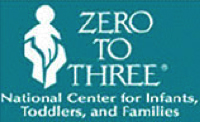
The National Training Institute, to be held in Seattle, WA, is ZERO TO THREE’s annual multidisciplinary training event for experienced early childhood professionals. The institute has been developed to meet the learning and networking needs of those working with infants and toddlers in child welfare, early childhood education, early intervention, mental health, parent education, and pediatrics. Registration information is available online.
30th Annual San Diego International Conference on Child and Family Maltreatment:
January 23–29, 2016
The objective of the San Diego International Conference—sponsored by the Chadwick Center for Children and Families—is to develop and enhance professionals' skills and knowledge in the prevention, recognition, assessment, and treatment of all forms of child and family maltreatment as well as enhancing investigative and legal skills. Topics include mental health and trauma, forensic interviewing, investigations, research, child welfare, and domestic violence as well as global issues and perspectives. Learn more about the conference from the conference website.
National Mentoring Summit: January 27–29, 2016
This annual event, sponsored by MENTOR, will be held in Washington, DC. The summit will bring together practitioners, researchers, corporate partners, government and civic leaders, national youth-serving organizations—and the network of affiliate Mentoring Partnerships—to explore and advance the positive impact of mentoring on individuals and communities. The theme for this year’s summit is "Connection, Growth, Opportunity." Learn more about the summit from MENTOR’s website.
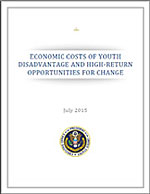 White House Report Highlights OJJDP Delinquency Prevention Models
White House Report Highlights OJJDP Delinquency Prevention Models
The White House's Council of Economic Advisers has released Economic Costs of Youth Disadvantage and High-Return Opportunities for Change, a report on closing opportunity gaps for disadvantaged youth. The report highlights two promising programs—One Summer Plus (OSP) and Becoming a Man (BAM). The White House has recognized the BAM approach as an example of innovation in advancing the goals of the My Brother's Keeper initiative for minority males.
The University of Chicago Crime Lab is currently testing both youth-focused delinquency prevention models with the help of OJJDP evaluation grants. For more on the OSP evaluation findings, read Summer Jobs Reduce Youth Violence Among Disadvantaged Youth. For additional details about BAM, read Not Too Late: Improving Academic Outcomes for Disadvantaged Youth.
Administrator Listenbee Testifies Before Senate Committee on Indian Affairs
 “[J]uvenile justice reform is an urgent matter, and nowhere is the issue more pressing than in Indian Country,” said OJJDP Administrator Robert L. Listenbee in his July 15, 2015, testimony before an oversight hearing of the Senate Committee on Indian Affairs.
“[J]uvenile justice reform is an urgent matter, and nowhere is the issue more pressing than in Indian Country,” said OJJDP Administrator Robert L. Listenbee in his July 15, 2015, testimony before an oversight hearing of the Senate Committee on Indian Affairs.
The hearing—titled, “Juvenile Justice in Indian Country: Challenges and Promising Strategies”—concerned the need for legislation to assist victims of crime in Indian Country and featured additional testimony from Darren Cruzan, Director of the Office of Justice Services for the Bureau of Indian Affairs; Addie C. Rolnick, associate professor at the William S. Boyd School of Law at the University of Nevada; and Carla Knapp, national director of Native Services for the Boys & Girls Club of America.
Administrator Listenbee testified that unique challenges exist for native youth, including high rates of trauma and suicide, lack of resources for tribal-based and culturally specific services, and jurisdictional issues that complicate juvenile justice cases. However, he noted that OJJDP is “stepping up to try to meet these challenges” through the use of Tribal Youth Program funding and other OJJDP funds to support trauma-informed programs using traditional practices at tribal communities in South Dakota and Montana, connecting more native youth to positive adult influences through the Mentoring Opportunities for Youth Initiative, and collaborating with the Bureau of Indian Affairs on updating the Model Indian Juvenile Code.
View more information on the witnesses’ testimony and a video of the hearing online.
OJJDP Updates Statistical Briefing Book With National Disproportionate Minority Contact Data
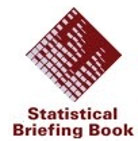
The OJJDP Statistical Briefing Book (SBB) has added new features to its National Disproportionate Minority Contact (DMC) Databook. The National DMC databook provides users with an understanding of the Relative Rate Index and an assessment of the levels of DMC at various stages of juvenile justice processing at the national level. This update provides data through 2013 and makes available new features, including DMC tables for combinations of gender and race for juvenile court stages, and tables comparing males to females for juvenile arrest and court stages.
Developed by the National Center for Juvenile Justice, the research division of the National Council of Juvenile and Family Court Judges, SBB offers easy online access to statistics on a variety of juvenile justice topics.
Keep up with the OJJDP Statistical Briefing Book on Twitter and Facebook.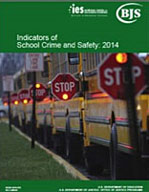
Bureau of Justice Statistics Releases 2014 School Crime and Safety Report
The Bureau of Justice Statistics, in collaboration with the National Center for Education Statistics, has released Indicators of School Crime and Safety: 2014. This annual report provides the most recent data on school crime and student safety. The indicators in this report are based on a variety of data sources, including national surveys of students, teachers, principals, and postsecondary institutions. Topics covered include victimization at school, teacher injuries, bullying and cyberbullying, school conditions, fights, weapons, availability and student use of drugs and alcohol, student perceptions of personal safety at school, and crime at postsecondary institutions.
View and download the report.
Bulletin Examines Children Exposed to Violence, Trauma and Implications for Policing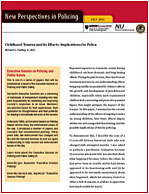
The National Institute of Justice has released a new bulletin in its New Perspectives in Policing series. Childhood Trauma and Its Effects: Implications for Police summarizes the effects of ongoing trauma on young children, how these effects impair adolescent and young adult development and functioning, and the possible implications of this for policing. The author argues that although children from any neighborhood can be exposed to violent trauma, children from poor communities of color are particularly at risk for such exposure. Because these communities are often the focus of police attention, it is important that police be aware of the high prevalence of severe childhood trauma in such communities, appreciate its effects on the developing child, and understand its impact on adolescent and adult functioning.
View and download the bulletin.
Office for Victims of Crime Releases Status Report on Federal Efforts To Improve Services for Trafficking Victims
OJJDP is among the Office of Justice Programs' agencies working with the Office for Victims of Crime (OVC) to ensure that victims of human trafficking in the United States have access to quality services. OVC has released the "Fiscal Years 2013–2014 Status Report for the Federal Strategic Action Plan on Services for Victims of Human Trafficking in the United States." The strategic plan defines 4 goals and 8 objectives and contains more than 250 associated action items for victim service improvements. The report documents the progress that federal agencies made during fiscal years 2013 and 2014 on each of the action items listed in the plan.
View and download the status report.
SMART Releases Report on Prosecution, Registration Alternatives for Juvenile Sex Offenders
The Office of Sex Offender Sentencing, Monitoring, Apprehending, Registering, and Tracking (SMART) has released Prosecution, Transfer, and Registration of Serious Juvenile Sex Offenders. This report examines the systems of charging, adjudication, disposition, transfer, and/or sentencing that might apply to a serious juvenile sex offender.
The landmark Sex Offender Registration and Notification Act (SORNA) set revised standards for states, territories, and certain federally recognized tribes to meet as they improved or established their sex offender registration and notification systems. One of the key changes in SORNA from previous federal legislation was the intentional inclusion of certain juveniles adjudicated delinquent of serious sex offenses in its registration and notification standards. This inclusion drew increased attention to the manner in which juveniles are adjudicated and sentenced for serious sex offenses in juvenile courts. What has not received as much attention, and is the focus of the report, is the full range of alternative approaches for prosecuting serious sex offenders in juvenile courts across the country.
View and download the report.
All OJJDP publications may be viewed and downloaded on the publications section of the OJJDP website. Print publications may be ordered online at the National Criminal Justice Reference Service website.
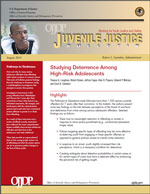
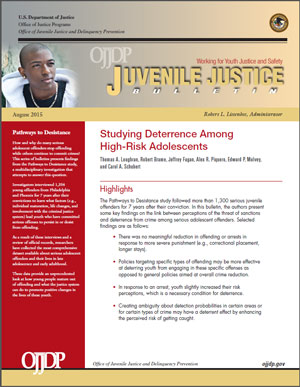 Studying Deterrence Among High-Risk Adolescents (Bulletin)
Studying Deterrence Among High-Risk Adolescents (Bulletin)
NCJ 248617
Pathways to Desistance Bulletin Series
This bulletin presents some key findings on the link between perceptions of the threat of sanctions and deterrence from crime among serious adolescent offenders. Some of the findings show that there was no meaningful reduction in offending or arrests in response to more severe punishment (e.g., correctional placement, longer stays), policies targeting specific types of offending may be more effective at deterring youth from engaging in these specific offenses as opposed to general policies aimed at overall crime reduction, and that in response to an arrest, youth slightly increased their risk perceptions, which is a necessary condition for deterrence.
View and download this publication.
Coming Soon—
Beyond Detention Series
The following bulletins from the Office's Beyond Detention series present findings from the OJJDP-sponsored Northwestern Juvenile Project—a longitudinal study of youth detained at the Cook County Juvenile Temporary Detention Center in Chicago, IL.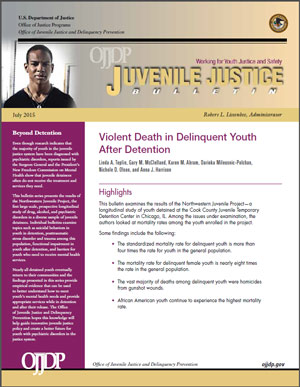
Violent Death in Delinquent Youth After Detention
The authors looked at mortality rates among the youth enrolled in the project. Among their findings: The standardized mortality rate for delinquent youth is more than four times the rate for youth in the general population. More specifically, the mortality rate for delinquent female youth is nearly eight times the rate in the general population, African American youth experience the highest mortality rate, and the vast majority of deaths among delinquent youth were homicides from gunshot wounds.
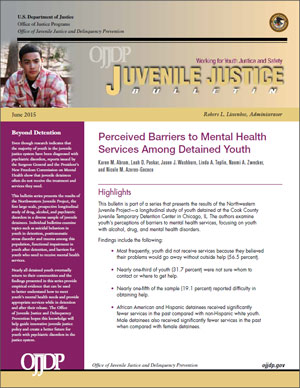
Perceived Barriers to Mental Health Services Among Detained Youth
The authors examined youth’s perceptions of barriers to mental health services, focusing on youth with alcohol, drug, and mental health disorders. Among their findings: Most frequently, youth did not receive services because they believed their problems would go away without outside help (56.5 percent); nearly one-third of youth (31.7 percent) were not sure whom to contact or where to get help; and nearly one-fifth of the sample (19.1 percent) reported difficulty in obtaining help.
Psychiatric Disorders in Youth After Detention
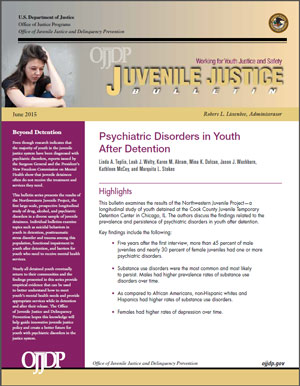
The authors discuss findings related to the prevalence and persistence of psychiatric disorders in youth after detention. Five years after the first interview, more than 45 percent of male juveniles and nearly 30 percent of female juveniles had one or more psychiatric disorders. Substance use disorders were the most common and most likely to persist. As compared to African Americans, non-Hispanic whites and Hispanics had higher rates of substance use disorders. Females had higher rates of depression over time.
Detained Youth Processed in Juvenile and Adult Court: Psychiatric Disorders and Mental Health Needs
This bulletin presents results of a study of the prevalence of psychiatric disorders among youth transferred to adult criminal court compared with those processed in juvenile court. Results of this OJJDP-sponsored study indicate that many youth are being transferred to adult criminal court, with males, African Americans, Hispanics, and older youth significantly more likely to be processed in adult criminal court than females, non-Hispanic whites, and younger youth. Among youth processed in adult criminal court, those sentenced to prison had significantly greater odds than those who received a less severe sentence of having a disruptive behavior disorder, a substance use disorder, or co-occurring affective and anxiety disorders.
 On June 22, 2015, the Coordinating Council on Juvenile Justice and Delinquency Prevention convened at the Department of Justice to discuss the results of a groundbreaking OJJDP-sponsored study, Closer to Home: An Analysis of the State and Local Impact of the Texas Juvenile Justice Reform. The study drew on 1.3 million individual case records maintained by three state agencies in Texas to assess the impact of state policy measures introduced between 2007 and 2012 in reducing the use of state-run correctional facilities for delinquent youth and keeping troubled youth closer to home.
On June 22, 2015, the Coordinating Council on Juvenile Justice and Delinquency Prevention convened at the Department of Justice to discuss the results of a groundbreaking OJJDP-sponsored study, Closer to Home: An Analysis of the State and Local Impact of the Texas Juvenile Justice Reform. The study drew on 1.3 million individual case records maintained by three state agencies in Texas to assess the impact of state policy measures introduced between 2007 and 2012 in reducing the use of state-run correctional facilities for delinquent youth and keeping troubled youth closer to home.
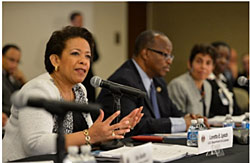
Attorney General Lynch speaks to members of the Coordinating Council.
Present at the meeting were Attorney General and council chair Loretta E. Lynch; OJJDP Administrator Robert L. Listenbee, Vice Chair; Roy Austin, Deputy Assistant to the President, White House Domestic Policy Council; and council members and designees from the White House Office of National Drug Control Policy and the Departments of Education, Labor, Health and Human Services, Defense, the Interior, Agriculture, Housing and Urban Development, Homeland Security, and the Substance Abuse and Mental Health Services Administration. Also in attendance were participants from the Corporation for National and Community Service and council practitioner members from across the nation.
In her first address to the council, Attorney General Lynch said, “For nearly four decades, this council has done some truly extraordinary work and made some outstanding progress on behalf of our nation’s youth.” Ms. Lynch also vowed to give her full support to the council during her tenure as the Attorney General.
Michael D. Thompson, director of the Council of State Governments Justice Center and one of the principal investigators on the study, presented the study findings. He was joined on the panel by Susan Burke, director of Juvenile Justice Services, Commission on Criminal & Juvenile Justice, Utah; John Tilley, Kentucky House of Representatives; and Randy Turner, director, Tarrant County (TX) Juvenile Services.
Although the number of youth in secure confinement had been in decline prior to 2007 when the first of the measures were taken, Thompson reported that only after 2007 did Texas see significant drops in the numbers of confined youth, decreases which he attributed to the legislative reforms.
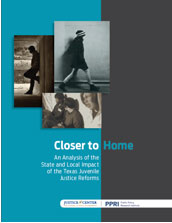
Even though the reforms were successful in keeping youth closer to home, the study showed that they had little to no impact on disproportionate minority contact and rearrest rates. The racial composition of youth in confinement did not change despite decreases in overall numbers, and there was little variation in rearrest rates for youth on probation and youth released from state-run secure facilities.
Some of the difficulty in assuring expected outcomes for youth, the panelists noted, could be attributed to how the community services were provided. Many did not match risk to need, and did not target the population most in need of their services—moderate- and high-risk youth. The panelists suggested strategies for improving youth outcomes, including restructuring contracts to hold providers accountable for outcomes attained and not only for services rendered, helping states make better use of risk and needs assessment tools to match the right kids to the right programs, and improving states’ capacity to acquire and analyze data that measures the impact of their reform efforts.
Improving outcomes for system-involved youth will require a paradigm shift in the way the juvenile justice system operates, concluded the panelists. “We’re trying to make change in an organizational structure that is so focused on this correctional mindset and not a youth developmental approach,” said Burke. “Everyone wants what’s best for kids, but [they] don’t necessarily know how to make that cultural shift, and it’s a slow process.”
Resources:
Watch a webcast of the meeting.
Closer to Home: An Analysis of the State and Local Impact of the Texas Juvenile Justice Reform can be downloaded at no cost from the Council of State Governments Justice Center website.
Meetings of the council are open to the public. Visit the website to register for the next meeting, learn more about the council, and read minutes from past meetings.
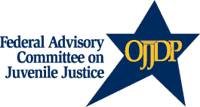
The Federal Advisory Committee on Juvenile Justice (FACJJ) held a webinar-facilitated meeting on August 24, 2015. The meeting included remarks by OJJDP Administrator Robert L. Listenbee, and FACJJ subcommittee reports on legislation, expungement and sealing of juvenile court records, and research and publications.
More information about the meeting will be available in the next issue of OJJDP News @ a Glance.
FACJJ meetings are open to the public; anyone may register to attend and observe. Additional information is available on the committee's website.
Resources:
The meeting materials may be accessed online.